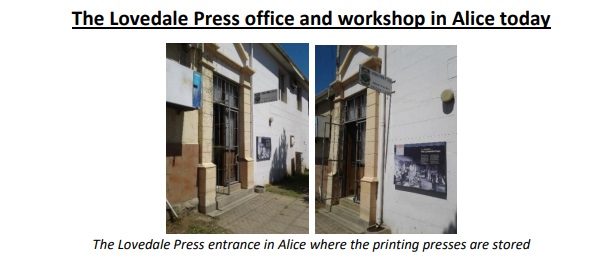
This rigid bed proof letterpress printing press was used to print books at the Lovedale Press, this specific model was built possibly between 1910 and 1920. In the 1960s it was rescued by Bob Hoskyn from the Lovedale Press as it was no longer in use. Carol Neith, his niece, offered the press to the St Patrick’s Chapel to find a home for it in 2020.
Trevor Webster fetched it from the outbuilding where it must have spent many decades. Gregorio Guzzo cleaned it and identified its usage. The press was ), donated to the Hogsback Library in November 2020 where it is displayed for visitors to appreciate an
early stage of the printing process of the book. The metal letters were placed on the rigid bed in a container (as the page displayed) paper was placed on the drum and ink placed on the three rolls with a palette. The handle manually rolled the drum to move across the rigid bed to ink the pages. It was a time-consuming manual process.

We take for granted these days the ease with which we can browse library shelves to find a book to our liking. However, it has taken centuries for us to reach this stage. The publication of books started with the development of writing on tablets, scrolls and papyrus in ancient days and the development of press-printed volumes and then mass-printed books. In the 19th century missionaries brought schooling, Christianity and the printed word to the Chumie Mission in the Amathole valley. This mission was established in 1820 by John Brownlee with the permission of King Ngqika, near the present-day Woburn Barracks. A mission village developed with farming and three years later, in 1823, John Bennie, printed the first Xhosa on a page. Today, instead of this historic site being commemorated by a grateful people, it is unknown, desolate and broken-down.
This small printing press at the Chumie (Tyumie) Mission in 1823 under Rev John Ross of the Glasgow Missionary Society was the start of the Lovedale Press. The mission on the Tyhumie was destroyed during the Frontier War of 1834-5, then the second mission on the Ncera was destroyed during the War of the Axe (1846-7). However, the third establishment of the Lovedale Mission on its present site was very successful and advanced missionary activities and advanced the education of South African black people.
The Lovedale Press provided a vehicle for South African black authors to publish their work and was a pioneer in printing African literature. Also, it allowed blacks to receive training as apprentices in printing and book binding. The Lovedale Press collection includes manuscripts and published works of many significant Black authors including AC Jordan, HIE Dhlomo, DDT Jabavu, JJR Jolobe, SEK Mqhayi, HM Ndawo, AZ Ngani, ST Plaatje, GB Sinxo, TB Soga, and Victoria Swaartbooi. The collection also includes tonic sol-fa and staff notation scores of such composers as MM Moerane, RT Caluza, E Sontoga, EAJ Monaisa, and B Tyamzashe.


The Beginnings of the Lovedale Press: the Chumie Mission
The Lovedale Press had its origins in the Chumie Mission in 1823. Its heritage is enormous in printing Xhosa and publishing Xhosa writers in this country. The Chumie mission was started by LMS missionary, John Brownlee, with permission from King Ngqika. The printing press played a pioneering role and influenced many Xhosa leaders like Tiyo Soga and Ntsikana. The first page of Xhosa was printed at Chumie with the printing press brought across from Glasgow and brought by wagon to the Chumie Mission in 1823.

John Bennie (1796-1869) is the Presbyterian missionary who printed the first Xhosa at the Chumie Mission in 1823. Before travelling to Africa, he had searched for literature in the African vernacular, but there was none. So, when he arrived, he set out to learn Xhosa with the aim of ’reducing to form and rule this language which hitherto floated in the wind’. At Chumie Bennie opened a school and developed the first orthography for Xhosa, spending the remaining fifty years of his life on the frontier.
His four children studied at Lovedale. In September 1823 the Rev John Ross arrived in Cape Town with a Ruthven press (this same press can be seen in the Missionary Museum, King William’s Town), type, paper, and ink and journeyed by wagon over a circuitous route of a thousand miles to Chumie arriving on 16 December 1823. Three days later, on 19 December 1823, the first fifty copies of the Xhosa alphabet according to Bennie’s orthography were printed. This is the first piece of printed continuous
Xhosa.

In a letter written to the Glasgow Missionary Society on 20 December 1823 from Gwali (the Chumie Mission), he wrote, ‘On the 16th we arrived and assembled (the printing press) in Mr Brownlee’s house, and thanked God for His mercy … On the 17th we got our Press in order; on the 18th the alphabet was set up, and yesterday we threw off 50 copies. Rejoice Sir, rejoice dear Society. Through your instrumentality a new era has commenced in the history of the (Xhosa) nation.’
Surely this pioneering event in the history of the printed word in Xhosa deserves national recognition. We hope that one day what happened on this spot in the Tyhumie valley will be appropriately recognised. In 1985 the Thembu poet or imbongi, DLP Yali-Manisi, wrote the following praise poem or izibongo, in recognition of John Bennie’s contribution to the written language.
Xhosa original of Izibongo ‘Siyabulela thina basemaXhoseni Ngokufika kweento zooRose nezooBheni Ukuz’ amaXhos’ avulek’ ingqondo Kulo mhla yaqal’ ukubhalwa le ntetho Intethw’ engqongqotho yasemaXhoseni.’ | English translation of Izibongo We Xhosa are ever grateful that men like Ross and Bennie came to ignite the mind of the Xhosa by first transcribing the language, the peerless language of the Xhosa. |
Trevor Webster
4 November 2020
